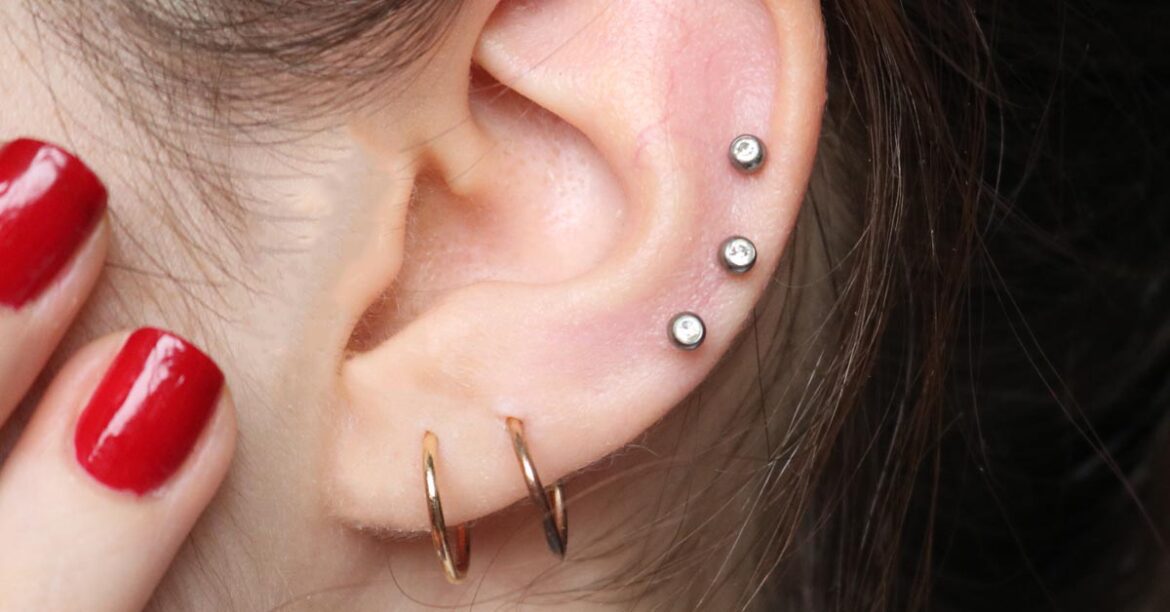What is Cartilage Piercing ?
Cartilage piercing is a type of body piercing that goes through the cartilage on the ear.
Cartilage is a type of tough, rubbery tissue that makes up the external ear and parts of the nose.
There are several different types of cartilage piercings:
Helix: This is the most common type of this piercing.
It goes through the upper part of the ear cartilage.
Tragus: This piercing goes through the small piece of cartilage that separates the ear lobe from the rest of the ear.
Rook: This is a less common piercing that goes through the thickest part of the cartilage at the top of the ear.
Daith: This is a piercing that goes through the ridge of cartilage at the innermost part of the ear.
Snug: This is a rare piercing that goes through the small piece of cartilage just below the ear lobe.
Ear Piercing Interactive Chart
What is The History of Cartilage Piercing?
The history of cartilage piercing is not entirely clear.
Some people believe that the first ones were done in India or Africa.
People used it as a form of body modification or tribal identification.
However, The first modern cartilage piercings were done in the late 1800s,
when body piercing became popular among the upper class in Europe and America.
These piercings were seen as a sign of wealth and status, and they were often done with gold or silver jewelry.
In the early 1900s, cartilage piercings fell out of fashion, but they gained popularity again in the 1970s.
Today, they are one of the most popular types of body piercings.
How Painful is Cartilage Piercing?
Cartilage piercing is not typically painful,
but it can be uncomfortable.
The pain level will vary depending on the type of piercing and the person’s pain tolerance.
Some people report feeling a sharp pain when the needle goes through the cartilage,
while others only feel a mild discomfort.
After the initial pain, many people report feeling a dull ache or throbbing sensation.
What are the Risks and Complications of Cartilage Piercing?
There are a few risks and complications associated with cartilage piercings.
The most common complication is infection, which can occur if the piercing is not done properly or if the jewelry is not clean.
Other Risks:
Allergic reactions: Some people may be allergic to the metal in the jewelry or to the cleaning chemicals used to keep the
piercing clean.
Keloids: Some people may develop keloids, which are bumps of scar tissue that form around the piercing.
Migration: The piercing may move out of place over time.
Dislocation: The jewelry may come loose and fall out of the piercing.
Bleeding: The piercing may bleed if it is bumped or irritated.
Swelling: The piercing may swell up after it is done.
What is the Procedure of Cartilage Piercing?
The procedure for cartilage piercing is relatively simple.
First, the area around the piercing is cleaned with a disinfectant.
Then, a needle is inserted through the cartilage and the jewelry is attached.
Finally, the pierced is cleaned again to prevent infection.
What is the Healing Time & Aftercare?
The healing time and aftercare for cartilage piercing varies depending on the type of piercing.
For most piercings, it takes about 4 to 6 weeks for the wound to heal completely.
During this time, it is important to keep the pierced area clean and dry.
How Do I Take Care Of a Cartilage Piercing?
Once you have a cartilage piercing, it is important to take care of it properly to avoid infection and other complications.
Here are some tips for caring for your piercing:
Clean the piercing twice a day with a saline solution or piercing aftercare spray.
Avoid touching the piercing with your hands.
Don’t put any lotions, oils, or creams on the piercing.
Avoid exposing the piercing to water for the first two weeks.
This includes showering, swimming, and washing your face.
Don’t sleep on the side of your piercing.
Sleep on your back or another position that will not put pressure on the piercing.
Avoid wearing tight clothing or headbands that could rub against the piercing.
What Type Of Jewelry Can I Wear For Cartilage Piercings?
The most common type of jewelry for cartilage piercing is a barbell.
But you can also wear other types of jewelry, such as hoops and studs.
How To Choose The Right Jewelry For Cartilage Piercings?
Once you have a cartilage piercing, you will need to choose jewelry to wear in it.
Here are a few tips on how to choose the right jewelry:
Make sure the jewelry is made from safe materials, such as titanium or surgical steel.
Do not wear jewelry made from metals that can cause an allergic reaction, such as nickel.
Choose a style of jewelry that you like and that will complement your other piercings.
If you are unsure what type of jewelry to choose, ask your piercer for recommendations.
How Much Do Cartilage Piercings Cost?
The cost of cartilage piercings varies depending on the type of piercing , the location and the experience of the piercer
For a standard earlobe piercing, the cost is usually between $20 and $50,
but the cost can be anywhere from $30 to $100.
To Sum Up
Cartilage piercing is a popular type of body modification that people make in many different places on the body.
The most common place to get it, is the earlobe.
However, it can also be done on other parts of the ear, such as the cartilage.
The procedure is relatively simple and the healing time is usually 4 to 6 weeks.
It is important to take care of the piercing during this time in order to avoid infection and other complications.
Overall, cartilage piercings are a popular way to modify the body and can be a fun addition to any wardrobe.
For other types of piercings PRESS HERE

